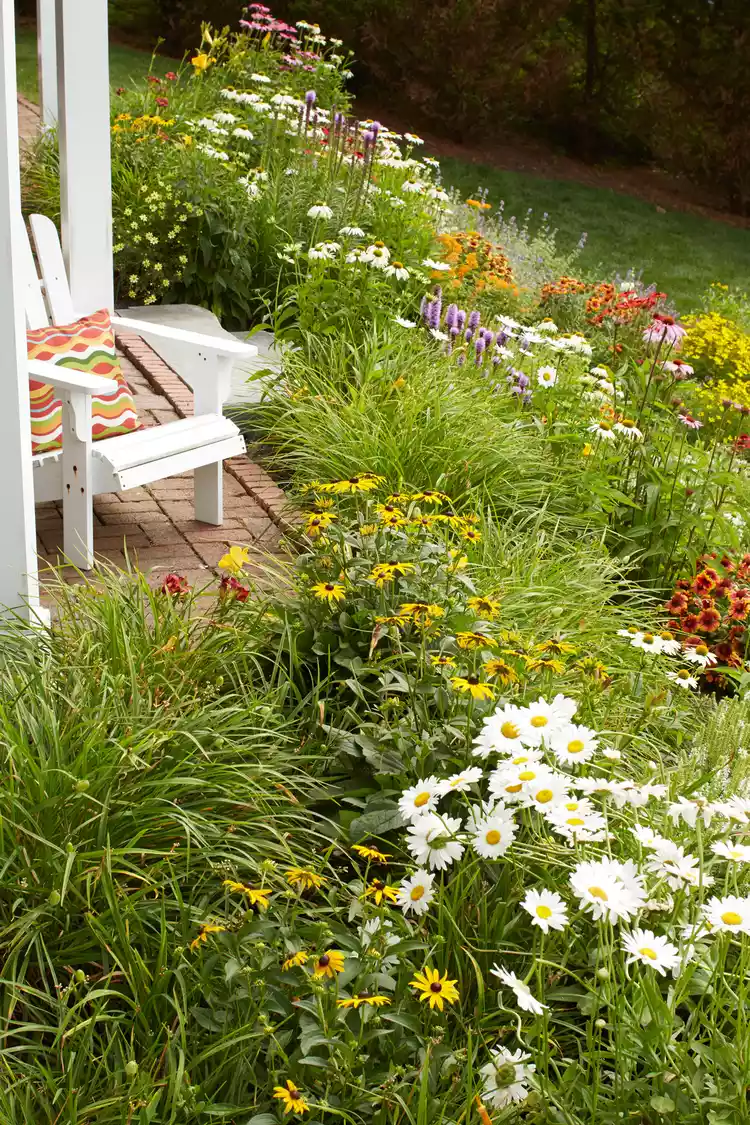A low-maintenance small garden design can give you a rewarding and relaxing outdoor retreat with less hassle and expense. Whether you’re working with an urban backyard or a rural slice of heaven, there are several strategies for creating a beautiful garden in a small space that won’t require a ton of work to maintain. Use the following ideas to choose the best plants and techniques to design a low-maintenance small garden perfect for your space.
Keep It Simple
It may be tempting to pack in lots of plants, outdoor furniture, and garden art into a small space. However, a more simplistic approach to garden accessories, hardscaping, and plant choices often ends up being far less time-consuming to maintain. Focus on less, not more, to create a serene space.
Plant Perennials and Shrubs
Garden centers are filled with beautiful annual flowers in various shapes, sizes, and colors. Before you buy, consider that most annuals need to be replanted each spring, which adds expense and time to planning, purchasing, and planting. Instead, opt for compact perennials and long-lived shrubs for a more low-maintenance small garden design. These plants cost a bit more upfront but save hundreds over the long run.
Nix the Lawn
Even a small lawn requires weekly mowing, regular fertilizing, and frequent watering. Consider replacing any lawn in your low-maintenance small garden design with easy-care small trees, shrubs, and perennials for a livelier aesthetic. If you prefer the open space a lawn provides, choose lower-maintenance alternatives like planting a clover lawn.
Try a Gravel Garden
Unlike rock gardens that can look somewhat barren while still work-intensive, gravel gardens are low-maintenance small garden designs that can be lush and full of life. By design, gravel gardens are constructed by amending the native soil and adding 5-6 inches of gravel above. Perennials, bulbs, and seeds are embedded in the soil below and grow through the gravel, providing a barrier for weeds while allowing water to reach the soil below.
Go Native
Native species have evolved in their local region for thousands of years, which means these tough plants can take whatever the climate throws at them throughout the year. In contrast, non-native plants usually need extra help to survive, whether additional watering or protection from wind, cold, and heat. Native plants will also benefit local wildlife, including pollinators.
Embrace a Naturalistic Look
Manicured French and English gardens are appealing with their clean-cut lines and elegant look, but these garden styles can be a maintenance nightmare. For low-maintenance small garden design, go for a naturalistic effect instead, such as creating a mini meadow around a seating area. Just let your plants fill their spaces as they would in the wild.
Limit Containers
Containers can be a handy solution for low-maintenance small garden design. However, growing plants in pots often requires additional effort to keep them watered and fed enough to thrive throughout the growing season. Instead of loading up your small garden with pots, stick to just one or two large accent planters. Make sure the containers are not clay; they dry out the soil quickly, so you need to water them often.
Fill the Border Garden
Border gardens encircle, outline, and define spaces in landscapes large and small while adding tons of color and texture. Fill your borders with low-maintenance perennials and small shrubs to create a comfortable and easy-care small garden. Full garden beds have the added benefit of blocking out weeds, so you can spend less time weeding.
Be Water-Wise
Being conscious of water use is important in much of the country and essential in arid regions such as the Southwest. To minimize water use and related maintenance, select drought-tolerant plants that do well in your local climate. Use water features like ponds and fountains sparingly, as they can be expensive, require maintenance throughout the year, and need to be filled regularly.
Create an Outdoor Seating Area
Add a sitting area to make the most of your low-maintenance small garden design. Repurposed bricks, second-hand or DIY outdoor furniture, and a small table will enhance the space and can easily be expanded upon if more room is needed later. Creating a brick surface for your seating area will cut down on weeds, reduce water use, and last for many years with very little upkeep.
Mulch Open Spaces
To reduce weeding, cover any bare ground in your small garden with a thick layer of mulch. Depending on the type of mulch you choose, it can last several years while helping to create an intentional and clean look in your low-maintenance small garden design. Mulch also helps the soil hold water, so you don't have to water as often.
More Ideas for Small Space Gardens
- 6 Tips for Creating a Low-Maintenance Cottage Garden
- 3 Small Urban Design Garden Ideas
- 3 Steps to a DIY Water Garden That Doesn’t Take Up Much Space
- 26 Tiny Plants Perfect for Miniature Landscaping
- 16 Small Space Landscaping Ideas to Make the Most of Your Plot
- 9 Best Dwarf Fruit Trees to Grow in Small Spaces




















